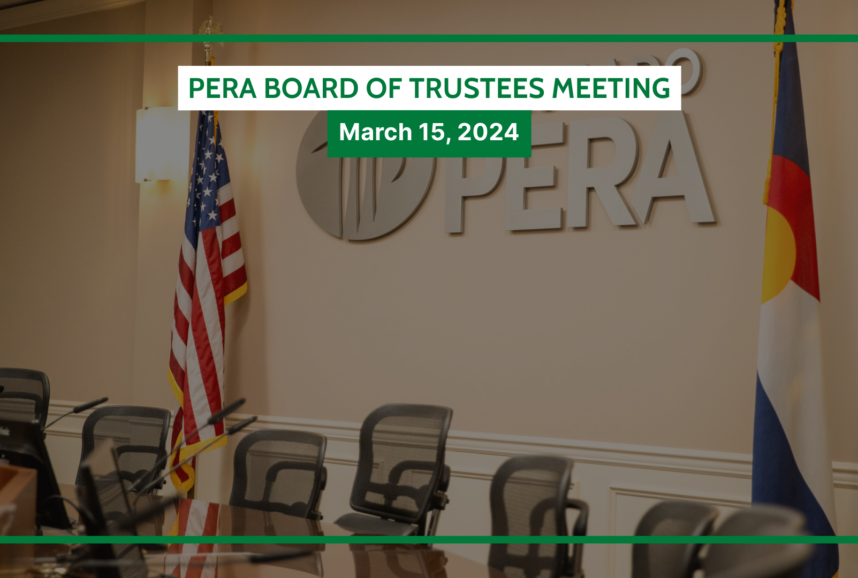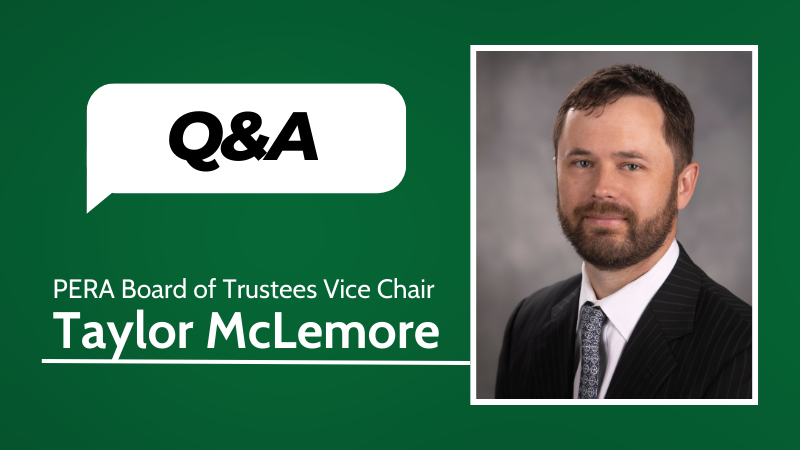On Thursday, April 27, Colorado PERA conducted telephone town halls for members and retirees. If you missed the calls, recordings have been posted here.
A summary of the most asked questions and responses is below. Questions about individual retirement benefits may be answered by contacting PERA Customer Service at 1-800-759-7372.
Q: What is PERA’s current funded status and are future benefit changes such as contribution increases or COLA reductions being considered?
A: At the end of 2015, the most recent data available, PERA’s funded status was approximately 60 percent and projections show PERA is sustainable. However, recent changes to external conditions have increased PERA’s risk level for retirees, members, taxpayers, and communities around Colorado. Risk is related to the plan’s ability to withstand a catastrophic economic event such as the 2008-2009 recession. The risk profile increases along with the plan’s vulnerability to a major economic downturn. To remain sustainable, it is important that PERA remain resilient and able to withstand major ebbs and flows of the market.
Currently, PERA is seeking to educate members, retirees, and the public with facts about PERA’s situation. For more details on PERA’s funded status and the risk associated with a longer time frame to reach full funding, please see the PERAtour website.
In response to the polling question: “Do you think PERA should take steps to address its funded status now, while not in a crisis?” More than 80 percent of the nearly 5,000 people who responded to the question said “yes.”
The PERAtour meetings will include an opportunity to weigh-in on the priorities and principles that should guide PERA’s process going forward. At the culmination of this process that will last over the summer, the PERA Board will receive all input for evaluation and possible recommendation to the Colorado General Assembly.
Q: What is PERA’s current investment return?
A: The 2016 investment return results will be available in late June and all members and retirees will receive the Summary Annual Financial Report in the mail (or via electronic delivery if selected) in early July. More details on PERA’s investment program may be found here. The next telephone town halls are scheduled for July 6, after the release of the 2016 Comprehensive Annual Financial Report.
Q: Why is my Social Security reduced because of my participation in PERA?
A: When the Social Security Act was passed by Congress in 1935, State and local governmental entities were specifically excluded from participating in Social Security. In fact, PERA predates Social Security by several years. Changes in the 1980s to Social Security made by Congress affect public employees who do not participate in the federal program. Learn more about the Windfall Elimination Provision (WEP) and Government Pension Offset (GPO) provisions of Social Security here.
Q: What is retiree PERACare, how does it work, and what is being done to ensure good coverage at reasonable rates?
A: PERACare is PERA’s voluntary health benefits program for retirees and benefit recipients, and includes health, dental, and vision care insurance programs. PERA is committed to providing a variety of plan coverages and is aware of the challenging health care environment facing not just Coloradans, but the country as well. Read more about PERACare.
Q: I have heard a lot of politicians expressing concerns about PERA. Why is PERA constantly a topic of discussion?
A: PERA believes conversations about the retirement system covering more than 560,000 current and former Colorado public employees should be based in fact and that’s why the PERAtour website was created. PERAtour, a statewide conversation, will visit nine areas of the state and host 12 public meetings with members and stakeholders between now and the end of June, with plans to continue the conversation in the fall. PERA staff will address the current situation and engage participants in discussion about guiding principles and potential changes.
The feedback from these meetings and conversations, as well as ideas from policymakers and other stakeholders, will be consolidated and reviewed by the PERA Board of Trustees to inform any deliberations about changes to the PERA plan design. All members, retirees, taxpayers, and interested citizens are invited to join in this very important conversation.
Still have a question? Submit it to PERAtour@copera.org.
Windfall elimination provisionA provision of federal law that may reduce Social Security benefit payments to retirees who receive a pension based on work during which they did not contribute to Social Security. The WEP does not apply to those with 30 or more years of substantial earnings in Social Security.Government pension offsetA provision of federal law that reduces Social Security dependent benefit payments to spouses, widows, and widowers who receive a government pension like PERA.ColaAcronym for cost-of-living adjustment; a type of annual adjustment meant to prevent a person from losing buying power due to inflation.





What is the rationale for the transition year when PERA is at risk of insolvencY?
Margaret,
Thank you for your question about working after retirement. First, PERA is sustainable and solvent. The ability for PERA retirees to return to work for a PERA employer allows for flexibility that employers and members sometimes need. Retirees are allowed to return to work for a PERA employer for 110 days in a calendar year.
Does the 80/20 rule apply, do 80% of the annual dispersements go to the top 20% of the recipients?
David,
We created a fact sheet that shows the distribution of benefit payments. Please see this link for details: https://www.copera.org/sites/default/files/documents/5-140.pdf
David,
Are you a PERA member or retiree? You ask an odd question. Benefits are based on years of service and your salary, not someone else’s salary.
Thank you for providing facts about our plan in a clear and understandable manner. Having the facts moves all of us away from the heated, and often non-factual, political and media rhetoric toward a calm and rational discussion of the concerns and issues. Well done
This publication doesn’t answer most of the questions. It is a total hedge. Why put this out without providing actual answers? My sense is that this publication is supposed to assuage anxiety, but its effect is just the opposite. It reads like a bunch of politicians got together to create the perfect non-answer to these most pressing questions. What a waste of time, both to create and to read.
Dear Jared,
Thank you for your candid feedback. Please let us know what your questions are by emailing us at PERAtour@copera.org and we’ll do our best to respond.
I agree with Jared. The questions were not really answered. A waste of time and concerning.
Not much there there, was there
I definitely agree with Jared’s remarks.
why doesn’t the PERA Board come up with some viable alternatives for discussion at the various field meetings? Arent they the ones with the most knowledge of the issues. Open ended meetings seem a waste of time.
“are future benefit changes such as contribution increases or COLA reductions being considered?”
Well???
I wanted to ask just how much money is needed, in an approximate figure, to fill the gap of the teacher fund and reduce the amortization period from its current level to 30 years?
My connection into the town hall call was dropped after 45 minutes. No one ever responded to the “0” that I pressed.
Please define “lifetime benefit” for your retirees.
It seems you (PERA) have no answers to what the future holds, only guesses. Is it because you really have no control over things such as contribution percentages and COLA reductions since that is actually decided on by the legislature, not by those who are employed by PERA who should be able to project the risks and make sound decisions for a viable future?
Hi. I now live in San Antonio. I retired after 20 years. I’m very satisfied with what I get right now. Will it continue. My husband now has ALZ and that’s pretty much all we have.